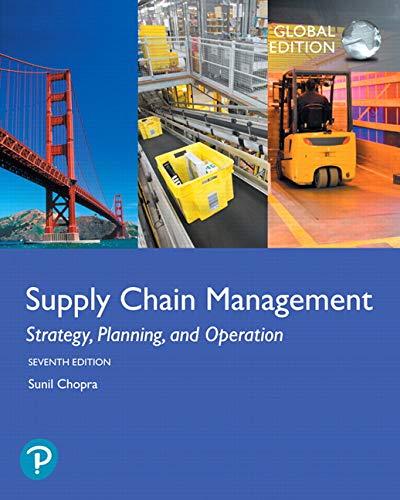Ed Hendrix, vice president of supply chain at 4Farmers, a large mixedfeed company in the Netherlands, Europe,
Question:
4Farmers has a high market share in specific feedstock for sustainable pork, called Euro-Grain. Euro-Grain was developed in the Netherlands, but supply volume from this country is not sufficient. Some other countries within Europe are also capable of producing grain that satisfies the Euro-Grain criteria, among them Poland. Ed believes that his company could significantly improve both distribution costs and environmental impact from transportation by investigating the possibility of using various modes of transportation.
Modes of Transportation
The supply chain uses a combination of the following modes of transportation: truck, inland ship, sea ship, and rail. As grain is not very perishable, speed is not really an issue. Prices vary with destination and depend heavily on the capacity of the transportation mode. Varieties of intermodal combinations are possible, using a truck, water, and rail combination with containers.
Distribution Alternatives for Warsaw
Ed asked his staff to propose different distribution alternatives for Poland: Nina Kramer on environmental issues and Leo Spoor on the costs, needs, and possibilities for the various transport modes.
Leo figured out that the demand of 4Farmers for Euro-Grain is about 3,500 tons of grain per month; he saw that from the farm near Warsaw,
grain can be transported by rail to the train station in Wroclaw (320 km) or the train station in Rotterdam (1160 km). By road, it is possible to reach the sea harbor Gdansk (330 km), the train station/inland harbor of Wroclaw (345 km), or even drive to 4Farmers directly (1197 km).
From the sea harbor Gdansk, a sea ship can travel to the sea harbor/rail station of Rotterdam (1064 km). An inland ship can travel from the inland harbor of Wroclaw to the inland harbor of Oss (950 km). The inland harbor of Oss can also be reached by inland ship from the port of Rotterdam (84 km). Finally, as 4Farmers can only be reached by truck, it takes 26 km to drive from the inland harbor of Oss to 4Farmers, and 100 km from the sea harbor/rail station in Rotterdam.
The distribution costs are $1 per km/ton for a truck with a capacity of 40 tons. A sea ship from the port of Gdansk to the port of Rotterdam costs $23.5/ton per trip with a capacity of 3,000 tons. While an inland ship from the harbor of Wroclaw to the harbor of Oss costs $13.75/ton per trip with a capacity of 1,000 tons, an inland ship from Rotterdam to Oss costs $3.75/ton per trip with a capacity of 1,000 tons. The rail tariffs for a capacity of 800 tons from Warsaw to Rotterdam: $25.4/ton.
Nina came up with the following information. The environmental impact of transportation can be represented by the following airborne emission categories: CO2 equivalents to represent greenhouse gas (GHG) emissions, NOX equivalents to represent nitrification, and SO2 equivalents to represent acidification. Table 14-12 gives the emissionequivalents per modality (per ton/km). Ed wondered which intermodal configuration would have the best sustainable performance for this supply chain.

Questions
1. Which intermodal configurations are possible for transporting the grain from Poland to 4Farmers?
2. Which intermodal configuration is the least expensive on a monthly basis?
3. Which intermodal configuration has the lowest GHG emissions (carbon footprint) on a monthly basis?
4. Which intermodal configuration would you suggest to be the most sustainable? Base your decision making on costs and the three environmental issues of greenhouse gas, nitrification, and acidification.
Step by Step Answer:

Supply Chain Management Strategy Planning And Operation
ISBN: 9781292257891
7th Global Edition
Authors: Sunil Chopra





